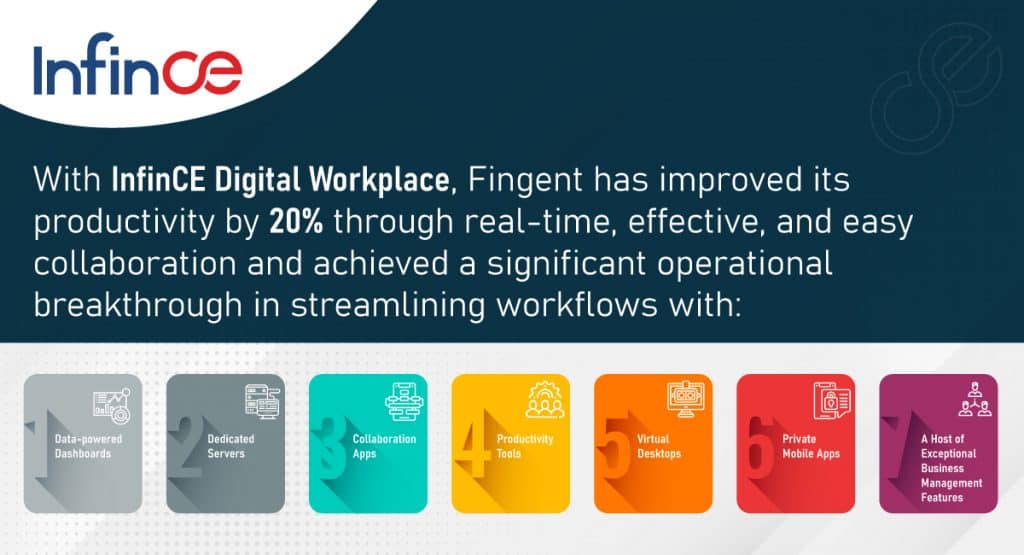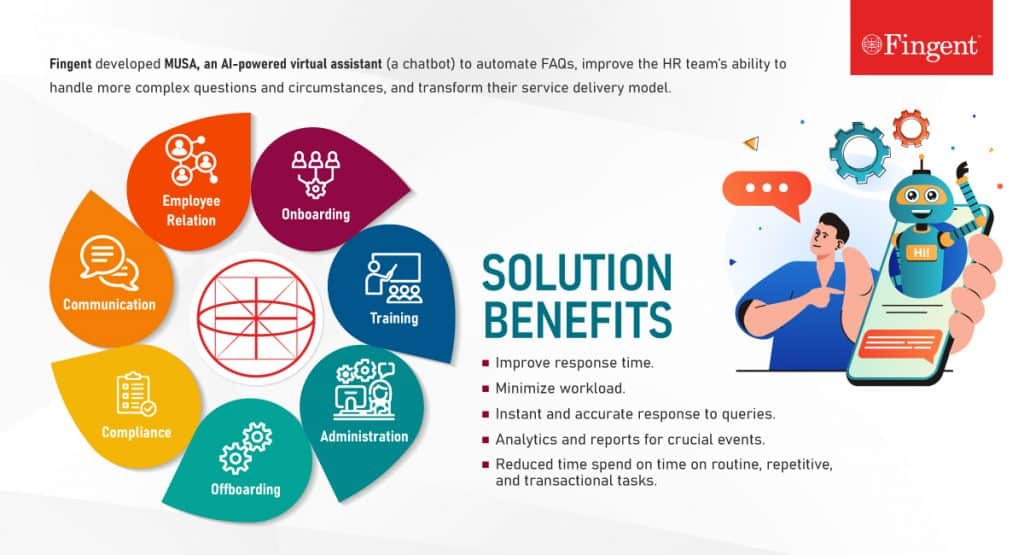Tag: RPA adoption
The strategic significance of advanced technologies as a critical business component is recognized by enterprises like never before. Besides business modernization and cost reduction, advanced technologies allow you to compensate for labor shortages, improve brand value and competency, and expedite research and innovation processes. However, several companies jump onto the bandwagon without properly understanding the practical applications and benefits of advanced technologies. The World Economic Forum indicates that only 23% of small and medium-sized enterprises (SMEs) worldwide can invest in and grow with new digital tools. This data proves why businesses should crucially analyze advanced technologies before adopting digital tools.
To streamline things, here’s a quick rundown of five advanced technologies we believe will help you cope with the new business and economic environment.
- Simplifying Workflows With Cloud
- Low-code Applications
- Robotic Process Automation (RPA)
- Document Data Extraction
- AI Assistants
As these technologies become more affordable and handy, businesses are ardently pursuing them to automate customer service, streamline workflows, differentiate products and services, and reach new markets. Depending on your budget, implementation timeline, priorities, and unique business requirements, our team at Fingent helps you build the roadmap for technology adoption.
Read more: How to gain maximum value from your technology investments?
Let’s take a closer look at the five inevitable technologies for business transformation today:
1. Simplifying Workflows with Cloud
Workflow management is a highly overlooked enterprise strategy that directly impacts productivity. Managing different stakeholders, heaps of confidential data, and a series of preset and conditional tasks manually can lead to several errors, such as employees missing key steps, policy violations, compliance issues, and monetary losses. By taking your workflows online, cloud-based workflow management applications increase your productivity.
Cloud-powered workflows or workflow management tools:
- Are scalable, centralized, customizable to your needs, easy to integrate, secure, reliable, and hassle-free.
- Offer a seamless and unified collaboration interface by preventing users from toggling between different messaging apps or communication channels.
- Reduce your dependency on the in-house IT team by passing on the software maintenance responsibilities to the third-party software vendor.
- Can be accessed via any authorized network (with approved access credentials), on any device, from anywhere, 24/7. This has been a huge game-changer for several companies that switched to remote operations during the pandemic.
Example of a Cloud-based Workflow Tool
Finding a cloud workflow management tool that can be customized to your company’s requirements is daunting. The platform should integrate well with your organizational processes without disrupting your workflow. This is where digital workplace applications like InfinCE make the difference.
With InfinCE Digital Workplace, Fingent has improved its productivity by 20% through real-time, effective, and easy collaboration. Data-powered dashboards, dedicated servers, collaboration apps, productivity tools, virtual desktops, private mobile apps, and a host of exceptional business management features enabled us to achieve a significant operational breakthrough in streamlining workflows.
Read the full case study here.
2. Low-code Applications
Gartner estimates that by 2025, 70% of enterprise applications will use low-code or no-code technologies. Digital business transformation requires pushing custom software solutions to the market at lightning speed. This demand has given rise to low-code applications that will break the technological and organizational silos of application development, automation, integration, and governance. Low-code development enables business users to bring innovative ideas to life by dragging and dropping low-code elements through a graphical user interface.
Simply put, low-code development enables “citizen” developers or non-tech users (such as business analysts or marketers) to build dashboards and survey or contact forms faster. On the other hand, professional developers can leverage low-code techniques to perform more efficient tasks, such as legacy application modernization or back-end integrations, with improved agility and velocity.
Use Cases for Low-code Applications
- Customer engagement applications and portals
- Mission-critical applications such as ERP software, payments manager, etc.
- Data analysis applications, BI dashboards, and data management software
- Mobile apps for customer engagement
- Order processing, inventory, order fulfillment, supply chain, and accounting apps
Salesforce Lightning, Microsoft Power Apps, and Zoho Creator are some of the leading low-code applications today. SAP users can leverage the unified low-code/no-code (LCNC) solutions on the SAP Business Technology Platform (BTP) to rapidly build and extend applications and automate tasks and processes.
Read more: Low Code/No Code Development with SAP BTP: How It Is Turning the Future of Enterprise Resilience
3. Robotic Process Automation (RPA)
Robotic Process Automation (RPA), often called software robotics, is an easy-to-use software technology that allows anyone to automate digital tasks within their business processes. RPA allows users to create software robots or “bots” to learn, emulate, and execute rules-based business processes. According to Forrester Research, RPA software revenue is expected to reach $6.5 billion by 2025, while RPA-related services revenue could hit $16 billion in the same year.
Potential Use Cases for RPA
We offer free proof of concepts to help you understand how RPA can improve your business efficiency and customer experience. Some of our top use cases include:
- Automating discharge protocols and data management to increase HR productivity in healthcare.
- Daily retail processes automation, such as order processing, inventory and warehouse management, etc., to save time and resources.
- Reducing customer wait times through RPA-enabled chatbots that answer customer queries in real time.
- Error-free, automated billing and invoices to keep your financial systems and reports up-to-date.
- HR teams can automate personnel data and records maintenance, streamline onboarding, and seamlessly manage payroll.
4. Document Data Extraction
Extracting quality data from unstructured or poorly structured data sources and documents for further processing, migration, and storing has been the biggest obstacle in automating back-office operations. If you enter structured invoices into a robust ERP tool like SAP, your payments can be automated, and system records can be generated automatically. Due to the high costs of data extraction, several businesses extract only critical information fields, for example, the payment field within an invoice. Businesses are compelled to manually extract data from other important fields, such as validating the invoice’s compliance with VAT.
AI-integrated OCR Software for Document Extraction
Optical Character Recognition (OCR) is an affordable, game-changing technology that automatically extracts data from the digital images (photos) of large files, scanned documents, and sub-titles or captions superimposed on an image. It reduces the time spent in manual data entry and extraction by automatically converting typed, handwritten, or printed text into machine-readable text. AI-powered automated data extraction tools like DocuSign, Docsumo, Kofax Capture, and Amazon Textract leverage OCR technology to reduce the chaos involved in document data extraction and enable businesses to create an efficient workplace.
Our team helps customize document data extraction software that can save you time and money by eliminating transcription and transposing mistakes.
5. AI Assistants
One of the most common examples of small business automation today is using AI-powered virtual assistants. They can save your employees’ productivity by automating the most repeatable customer interactions, such as technical support, appointment scheduling, lead qualification, and order management. AI virtual assistants like Google Assistant and Alexa can understand and act according to your voice commands and customize responses to your queries. Understanding customer intent through natural language processing and recognition allows AI assistants to maintain a human-like conversation.
Chatbots are a popular category of AI assistants designed specifically for text-based channels like SMS, email, and live chat. Recent years have witnessed a rise in chatbot adoption among several business verticals, product and service lines, websites, mobile apps, customer portals, etc. Data shows that 58% of B2B companies and 42% of B2C websites use chatbots to make their websites and mobile apps more interactive. More than 56% of businesses believe chatbots to be driving digital disruption in their industry.
Case Study: AI Virtual Assistant for HR
Fingent’s HR team was pressed to transform their service delivery model as routine, transactional tasks affected their performance and efficiency. To solve their struggle, Fingent developed MUSA, an AI-powered virtual assistant (a chatbot), and integrated it with Fingent Hub, Fingent’s internal employee management system. MUSA is short for Multi Utility Assistant. Employees can ask MUSA any queries related to HR and IT DevOps processes at Fingent, and they’ll get answered instantly. MUSA has improved our HR team’s response time by minimizing their workload and allowing them to focus on areas requiring more attention.
Business and Technology Are Inseparable!
Gartner writes that businesses with technology employ advanced tech to boost customer experience and revenue growth, clearly understand their priorities, goals, and strategies, and invest in solutions tailored to their needs. Technology allows businesses to lower the walls within and between their organizations, customers, providers, suppliers, etc. Organizations perceiving technology as a key business consideration will be able to match the pace of business change and stay relevant and competitive.
How can your business embrace growth in a new era of transformation and technology trends?
If you’re getting caught in the technology maze, take a quick break to contact us. Our consultants can simplify your technology adoption strategy based on your priorities, customer needs, financial resources, and technical requirements.
Stay up to date on what's new

Featured Blogs
Stay up to date on
what's new



Talk To Our Experts
It apparently took 20,000 to 30,000 men to lay 2.3 million blocks to build the pyramid of Cheops, and it would have taken approximately 20 years to complete if the stones were laid at the rate of one every two minutes. Manual labor – tedious and time-consuming! Thanks to Robotic Process Automation (RPA) technology, most businesses can now be liberated from arduous work and improve their business process to gain increased profit.
Robotic Process Automation technology is bolstering businesses across industries. Software robots do repetitive and lower-value work and advanced robots can even perform cognitive tasks like interpreting the text, understanding unstructured data, and plying advanced ML models to make complex decisions.
Are you a business leader considering whether to move to RPA or not move to RPA? This blog can clarify any doubts you may have about RPA.
But what exactly is RPA?
What is RPA?
Robotic Process Automation is a software technology that is capable of imitating human actions while interacting with digital systems and software. Like us, it can understand what is on the screen and perform a wide range of defined actions. The only difference between us and RPA is that software robots can accomplish tasks faster and more consistently than we can ever do. Plus, they don’t need to stretch or go for a coffee break.
How RPA Is Impacting Today’s Businesses
Robotic Process Automation is a clear and viable way to maximize efficiency, reduce costs, and enhance productivity. Though RPA is fairly new, it is gaining rapid traction across industries. Businesses are turning to RPA to minimize human effort.
According to a Deloitte RPA survey, 53% of respondents have begun their RPA journey by 2020, and this is expected to increase to 72% in the next couple of years. Why are so many companies adopting RPA? Here are a few reasons:
- Employees spend 10%-25% of their time on repetitive tasks. Implementing RPA will save that time for more productive work.
- Typical rule-based processes can be automated by 70% – 80%.
- IT departments of an organization spend 30% of their time on basic low-level tasks. Obviously, RPA adoption can save precious time for the IT department, which can be better used elsewhere.
Why Your Business Needs RPA?
RPA is a user-friendly and cost-effective tool. The advantages it can provide are drawing interest from organizations from various sectors globally. Here are some business benefits for your consideration:
- Easy implementation: RPA implementation does not require programming skills. Non-technical staff can teach the bot how to perform an automated task with the help of a process recorder feature.
- Less prone to make mistakes: RPA bots are extremely accurate and consistent. They are less prone to typo errors than a human worker. This feature is extremely beneficial in tasks such as setting up or removing user accounts, onboarding and offboarding employees or filling out information from another system.
- Meet strict compliance standards: Once configured, RPA bots strictly follow the step and provide an audit trail for each step. This controlled nature is well suited for companies that want to automate their processes end-to-end while meeting regulatory compliance standards.
- Work with existing systems: RPA doesn’t require any changes to your current system. It can be included as part of your automated business process.
- Increased productivity: RPA improves process cycles and completes them faster when compared to manual processes.
Read more: Is It the Right Time for Your Business to Invest in Robotic Processing Automation?
Now that you know why your business needs Robotic Process Automation, would you like to know what some potential areas of your business that can effectively implement RPA are?
Potential Business Areas to Implement RPA Effectively
Here are some sectors that use Robotic Process Automation effectively:
1. Report Generation: Report generation is a time-consuming and tedious task as data must be collected from multiple sources and collated accurately. RPA takes care of this task allowing employees to directly get to drawing actionable insights from the collated information.
2. Customer Service: RPA can be set up to quickly handle the first two or three customer interactions before reaching a human executive.
3. Accounting: RPA helps increase the speed of accounting, such as on-time invoicing and quicker fund release. You can fine-tune it to ask the vendor for relevant documents in case of any complexity.
4. Fraud detection: RPA enables banks to detect any anomalies in transactions and flag them against a fraudulent customer. It can reduce the time taken for fraud detection and investigation.
5. Data exchange: Data exchange is often time-consuming and error-prone. RPA can maximize productivity by reducing transaction times from hours to minutes. It can also minimize errors and maintain clean and organized data for business compliance results.
6. Reduce cost and manual labor: RPA limits your labor expenses and increases productivity. This contributes to consistent work. It also reduces errors at work, which prevents time wasted on correcting errors and redoing the work. Thus, it is more cost-effective while minimizing manual labor.
Top Sectors That Can Benefit From RPA
- Property management: Real estate businesses can use RPA to generate invoices automatically regarding property management. It can also reduce the turnaround time, leading to reduced operational costs.
- Retail: These businesses can use Robotic Process Automation to monitor inventory and email sales. It allows retail businesses to monitor competitors’ websites to gain insights on products or customer service.
- Finance: Finance companies can use RPS to manage customer accounts, data migration within accounts, sending and receiving payments, and more.
- Healthcare: Manually recording patient data and updating it can take enormous time. You can automate this process through RPA to reduce workforce concentration. Also, you can leverage these insights to provide more personalized healthcare services.
Read more: Deploying RPA for Finance, Healthcare & IT Operations
Tips To Choose The Right RPA Partner
Once you have your strategy in place, consider these points in choosing the right RPA partner:
- Skills: What skills or certifications matter to you most?
- Bots: What kind of bots do you need for your strategy?
- Capabilities: Do these bots have the cognitive capabilities to handle unstructured data sources?
- Recorders: Does your provider have tools to record workflow?
- Scalability: Can your partner scale as per your requirement?
- Solutions: Are their solutions reliable?
- Reusability: Does your partner follow a modular automation approach?
- Process designer: Can your partner provide you process designer approach that suits your business?
- Cost: Find out upfront if the cost includes licensing, ongoing maintenance, and support.
Read more: Robotic Process Automation: Choosing The Right Solution For Your Business
Ready to Transform Your Business With RPA?
Given the apparent advantages of Robotic Process Automation is one of the best tools to adopt in the current business world. However, selecting the right RPA partner can be a demanding process. Do your due diligence, speak with our experts and see what exactly you need to be looking for and if we are a good fit for you.
Once implemented, you can be confident that your business will benefit from better results and improved efficiency, which translates into higher revenues.
Stay up to date on what's new

Featured Blogs
Stay up to date on
what's new



Talk To Our Experts
Robotic Process Automation (RPA) is not just a “nice-to-have” option anymore. If you want to remain competitive it is an absolute necessity.
As a most promising technology enabler, RPA helps improve speed, quality, and productivity. RPA strengthens the organization, ensuring that it is ready to deal with disruption and change. This blog will discuss how it is making a mark in Finance, Healthcare & IT operations.
What Is RPA?
Robotic Process Automation (RPA) is an end-to-end approach that can automate workflows without the intervention of a human being. This approach allows users to configure software that enforces business processes. RPA software can collect, interpret and orchestrate applications to perform various repetitive tasks.
RPA is a technological breakthrough for industries like finance, healthcare, IT, telecommunications, banking, insurance, retail, property management, and many more. Industries that implement RPA can automate their workflows, infrastructure, and other labor-intensive and time-consuming processes.
RPA is both cost-effective and user-friendly. It is no surprise, industries are racing to unlock value from RPA, including digital labor.
Watch now: How Robotic Process Automation Is Building Better Workplaces
How Is RPA Revolutionizing Industries?
- Increased Accuracy: Bots are less prone to make mistakes or typos than human workers.
- No interruption of workflow: Virtual robots can operate 24/7 without staff initiation.
- Meet strict compliance standards: Configured bots can provide an audit trail for each step and retrace the steps, in case of a process review.
- Work with existing systems: Robots do not need extensive IT resources; they work with the layers of existing applications.
- Improve employee morale and experience: Bots offload manual tasks from employees and enable them to focus on strategic, revenue-producing activities.
These advantages sound good. But, how does this ‘digital worker’ (RPA) streamline business processes? Let’s see.
How Can RPA Streamline Processes?
1. Employee Onboarding
Employee onboarding is a costly and time-consuming process. Zippia’s research showed that the average cost per hire is $4,425, or 40% of an employee’s base salary. Not just that, it takes about 36 to 42 days to complete the onboarding process.
Fortunately, RPA can reduce both the cost and the time taken to onboard an employee. How can it do that? It can do it by automating all repetitive and rule-based tasks.
For example, a bot can accurately source an applicant 24/7, and without any bias. After which, it can assist in screening resumes and candidates. Further, a bot can handle much of the paperwork that the company needs to fill out.
2. Auditing
Although audit practice has improved over the last 30 years, a massive amount of manual, repetitive, and rule-based tasks still take up much of the auditor’s time.
Examples of these tasks include file organization, the performance of basic audit tests in excel, manual annotations, and many more. These tasks are not only labor-intensive, but they are also prone to error.
RPA offers the ability to connect otherwise unintegrated audit activities. In addition to the obvious time-saving benefits of RPA, there are financial advantages. For instance, PwC estimates that 45% of repetitive work can be automated, and this would save $2 trillion in global workforce costs.
Beyond simple cost savings, automation can enhance an auditor’s ability to do his job. By freeing up an auditor from mundane, repetitive tasks, RPA allows them to focus on the more complex aspects of their job.
By sifting data more accurately than human auditors, RPA can help human auditors to scrutinize whether an accounting treatment or client behavior is reasonable. With such improved efficiency, auditors can make a final determination about optimizing costs.
3. Invoicing
Invoice processing is a crucial business operation. Yet, these tasks are labor-intensive, error-prone, and do not directly generate revenue. RPA is designed to manage such tasks effortlessly and efficiently.
For instance, when invoices come through various channels, they have to be matched to purchase orders, and then most often, they need to be approved by different people for payment.
RPA allows you to automate the purchase order matching process to flag any errors for further scrutiny before submitting the payment. You and also create rules to send invoices to the right people for approval automatically. RPA can automate all the data entry and manual processing involved in accounting and finance.
These are just a few examples that show how RPA can drive faster response and improve business processes.
Now that we understand how RPA streamlines processes, which of the top industries benefit from adopting RPA?
Read Whitepaper: Learn how RPA can bring a difference to your business and give you a competitive edge!

Top Industries That Can Benefit
Some industries that think automation is a costly effort have witnessed early adopters of RPA outperform the rest of the businesses with an increased ROI. According to Gartner, the RPA market is expected to grow at double-digit rates through 2024.
1. Robotic Process Automation in Finance Sector
Finance sector applications include managing customer accounts, migrating data between accounts, updating loan and mortgage data, and more. Just by defining the rules, Robotic Process Automation can help financial services to meet compliance standards.
RPA technology is accurate. Hence, it significantly reduces risk in the finance sector. Faster RPA cycles are highly scalable and rapidly deployable.
2. Robotic Process Automation in Healthcare
The pandemic has increased the volume of patients substantially, and healthcare industries are prioritizing efficiency and cost reduction. These two are major benefits of RPA implementation in the healthcare sector.
- Improved quality: RPA implementation automated and simplified entry process, claim process, maintenance of medical records. This enabled healthcare personnel to tackle the large volume of patients, especially those who need individual care and attention.
- More human workforce to care for more patients: RPA implementation replaced the workforce that performs mundane repetitive tasks. Healthcare professionals now have more time to spend on core activities rather than perform mundane tasks.
3. Robotic Process Automation in IT
Today, business operations depend on how well the IT system is managed. Leveraging RPA in IT operations is worthwhile. Consider why:
- Helps manage high volumes of data: Managing high volumes of data from different locations and different departments can be challenging. In contrast, RPA can process large datasets with greater agility, and complete the process faster and with no errors. Moreover, Robotic Process Automation systems can also update changes in the data in real-time.
- Enhances customer experience: Employees are required to respond to any inquiry adequately and on time. Anything less could push your customers to your competitors. Automating repetitive tasks frees up agents to focus on more customer-related tasks such as pitching in a sale or providing end-to-end product engineering solutions.
- Better patch management: Manually patching IT systems is always a bad idea because it leaves more room for errors and is time-intensive. Implementing RPA can help synchronize the vulnerability database, scan machines for missing patches, and deploy the missing patches. This way automation ensures that the system is always protected.
Read more: Drive business growth with RPA!

How Fingent Can Help Deploy RPA Seamlessly
Successful implementation of Robotic Process Automation depends on a clear understanding of the task at hand. At Fingent we can make the implementation a lot easier. We can help you automate parts of your process or the entire thing.
With automation under one wing and cognitive technologies under the other, Fingent ensures you are in complete control. We can help you discover new, effective automation ideas. As a professional partner, we help you identify your strengths and areas of improvement and then work with you to build an action plan with tactical and strategic solutions.
Fingent also provides both onsite and offsite training and maintenance to ensure you get maximum ROI. Give us a call and let us help you get this rolling.
Stay up to date on what's new

Featured Blogs
Stay up to date on
what's new



Talk To Our Experts
The COVID-19 pandemic has created an imbalance between the supply and demand of the goods thereby disrupting the supply chain globally. That said, it has also amplified the need for technology tools to manage the supply chain challenges as the possibility of lockdowns in the future can’t be overlooked.
With the increasing demand for autonomous solutions, it is not surprising to see companies investing in supply chain technologies. According to Gartner, by 2023, 50% of the global eCommerce companies will invest in the real-time supply chain, AI, and advanced analytics solutions.
Challenges in the Supply Chain
1. Labor and material shortages
2020-21 witnessed several layoffs and quarantine putting the market in flux globally. Leaders not only face delegation woes but also find staffing key positions within procurement and supply chain ops problematic. Leaders will have to rely on technologies and automation to create cohesion and shift focus to smaller more concentrated procurement teams.
According to the Institute of Supply Chain Management report, every key commodity is either scarce or up in price leading to shortages and complexities to supply chain management. In other words, the material shortage will continue and companies can expect persistent problems through 2022.
2. Rising freight costs
In 2021, trucking and intermodal transport shot to new highs while spot prices doubled across the board: van (+18%), reefer (+25%), flatbed (+27%). Additionally, sea freight price and air freight price skyrocketed as well making it difficult to move freight in any capacity.
Thus, fluctuation in freight price will remain one of the biggest challenges the supply chain industry will have to face in 2022.
3. Port congestion
In the last two years, there have been wait times for ships headed into ports across the world. In October 2021, over 50 container ships were amassed outside Los Angeles and Long Beach to unload cargo from China. That said, gridlock especially at overseas ports creates delays as ships look to obtain cargo. So, bottlenecks at both ends cause additional lead time for import-export operations ultimately disrupting the domestic supply chains.
While port congestion isn’t a new problem, according to The National Customers Brokers & Forwarders Association of America (NCBFAA), 2022 could see historic wait times and supply chain bottlenecks.
4. Problems related to demand forecasting
While the global shutdown in 2020 skewed supplier data to a great extent, 2021 saw some recovery making the data relatively unreliable as a standard for future forecasting. This has resulted in no proper benchmark for supply chain leaders to follow.
As the unprecedented demand grows, meeting it remains a challenge. So, supply chain leaders will have to rely on trending data to predict the year considering the previous benchmarks for everything from inventory to budget and pricing.
Read more: Logistics Management Software – Everything You Need To Know!

While this adjustment is completely different for those who rely on the last two to three years trailing data to estimate demand forecasting, it is a challenge that requires forethought.
Here are five technologies that will help advance your business in 2022.
1. Robotic Process Automation (RPA)
According to Deloitte, RPA will see strong growth in the next five years specifically in the supply chain operations that include lower-value, potentially dangerous, or high-risk tasks. Robotic technology applications include trains and trucks, automated vehicles like drones, last-mile deliveries, and storage and retrieval systems (ASRS).
The use of RPA can achieve the following objectives:
- Improve productivity and efficiency
- Reduce re-work and risk rates
- Increase employee safety
- Perform repetitive and mundane tasks so humans can work more useful tasks
- Increase revenue by improving order fulfillment and delivery speed
New pricing structures are helping companies consider investing in automation. That said, the RaaS (Robotic and a Service)-type model allows providers to lease units through a monthly service contract instead of customers paying a huge capital up-front.
2. Cloud computing and AI
As supply chains generate big data, cloud-based AI can be used to turn that data into insights. Cloud computing along with AI has transformed the way the supply chain operates and in near future its abilities will only grow in complexity.
Cloud and AI systems can use past trends and market indicators to achieve the following processes;
- Powering automation process
- Informing supplier selection
- Providing real-time information on shipments
- Analyzing carrier performance
- Streamlining supplier onboarding and automating supplier management
- Anticipating trends in operational issues
- Augmenting customer support
Read more: How to accelerate your business growth with Robotic Process Automation

3. IoT
Asset tracking through IoT will help save time and money and assist data-driven decision-making.
Through GPS tracking of shipments and monitoring parcel conditions, IoT devices have improved quality management in the supply chain. RFID chips, mobile sensors, and smart devices can track and authenticate products, humidity, light levels, measure temperature, handling, movement, speed, and other environmental factors of shipments.
Additionally, IoT facilitates new fleet management solutions development which helps improve workflows and customer satisfaction. Also, IoT in the future will reduce the total cost of ownership and make the entire supply chain industry more connected, driven by legislation and customer demand.
Adoption of IoT will also improve security and decrease the probability of piracy, disruption of refrigeration, and container damage.
4. Blockchain
Emerging technology in the supply chain industry, blockchain’s decentralized digital ledger can help improve transparency for customers. This will enable them to track the whole journey of a product before arrival. Additionally, blockchain can increase transparency in audits and improve security by revealing any attempted fraud. Blockchain can help increase the level of trust and make digital payments more secure.
Blockchain systems can also save time and money due to better coordination of documents and eliminate the need for physical paperwork.
5. Transportation Management System (TMS)
All of the above-mentioned technologies need to be organized and managed from a single point. That is where TMS applications complications come into the picture.
TMS is used to manage carriers, and help convert paper-based documentation into a digital format. It will reduce freight costs, track deliveries in real-time, and increase transparency which will eventually improve customer service. Simply put, TMS will help make all the separate elements work as a single system.
TL Nika Logistics is a prime example of successful TMS adoption.
Final thoughts!
There’s no denying that technological innovation is propelling supply chain management solutions. If you are looking to embark on this technical journey, Fingent is the right partner for you. We understand the latest advancements in supply chain technology and help organizations adopt these emerging solutions while gradually replacing legacy systems to help navigate better in this competitive business landscape.
Connect with us today!
Stay up to date on what's new

Featured Blogs
Stay up to date on
what's new



Talk To Our Experts
As digitalization is gaining a lot of significance, many enterprises are turning to emerging technologies such as Robotic Process Automation(RPA) to streamline their operations and reduce costs. RPA automates mundane processes allowing organizations to devote more time to serving customers or other important work.
According to Gartner, Inc. , Global RPA software is projected to reach $1.89 billion in 2021, an increase of 19.5% from 2020. Despite the COVID-19 pandemic, the RPA market is estimated to grow two times by 2024.
Read more: How to accelerate your business growth with Robotic Process Automation
What is RPA?
In simple terms, RPA is an application in which a software bot leverages a combination of automation, computer vision, and machine learning technologies to automate repetitive and high-volume tasks.
RPA solutions are best suited for processes that are labor-intensive, repetitive, and have predictable interactions with IT applications. Typically, these processes may be too small in value to be automated via IT transformation. RPA tools help improve the efficiency and effectiveness of such processes without changing the existing infrastructure.
RPA software bots can perform various business processes by mimicking how humans interact with applications through a user interface and simple rules to make decisions. As a result, robots can complete the entire end-to-end process with very little human interaction.
Benefits of RPA include;
- Improved accuracy
- Flexibility and scalability
- Speeds up the processing time
- Better employee morale
- Reduces manual and repetitive tasks
- Enables better customer care
- As per Forrester, projects see a 15-month payback, 229% ROI on average
Key business challenges RPA helps address are;
- Login automatically into a system as a user
- Helps navigate around the software, using menus and shortcut keys just like a human moving the mouse or typing on the keyboard
- Interpret labels to read values from the screen. If the screen content or web page is dynamic, RPA can help find the right value on the screen.
- Read values and data from PDF reports automatically and add them to data tables.
- Inputs values into a capture screen automatically by mimicking the user’s actions. However, it can process it several times over with different values for each pass.
- Read emails and messages to understand the information they contain. For example, is the sender placing an order, making a booking, looking for information, or sending an invoice? Based on the intent, RPA will trigger the process with the message.
- Help trigger a process in a system by logging in as a user and clicking buttons.
- Collate different pieces of information and identify the next best action in the process.
Read more: How Can Businesses Overcome The Barriers To RPA Adoption?
Who is using RPA?
RPA can be leveraged by any business, especially if it involves repetitive tasks such as banking, healthcare, finance, insurance, and telecommunications. For example, RPA can be used in finance to automate governance, reconcile accounts, or process invoices. Additionally, RPA can help automate processes such as data entry, predictive maintenance, and after-sales service support in the supply chain.
Telecommunication companies utilize RPA solutions to organize new services and all the related billing systems for new accounts. RPA also helps these companies pull data from multiple systems when old equipment outages or predicts problems.
Regardless of the industry, RPA benefits the larger organizations and small and mid-size companies with its ability to streamline business processes and improve efficiency.
Should you invest in RPA?
The pandemic has caused a sudden surge in RPA as businesses are turning to cost-effective solutions to fill the workforce gap due to a shortage of employees. But again, if there is a lack of data or the process is obsolete, opting for RPA may not be a wise decision.
With the RPA market evolving, it is becoming affordable for even small and mid-size businesses who want to stay ahead of their competitors. According to the Grand View Research report, in 2019, the large enterprise segment accounted for over 67% of the global RPA while the BFSI led the market in terms of application with over 29% share of the global revenue. However, from 2020-2027, it is estimated that SMEs will witness the highest CAGR, with the pharma and healthcare sectors leading the way application-wise.
While RPA can fill the gaps in the current system and benefit the organization as a whole, companies that have large volumes of data and time-consuming business processes with well-defined rule-based steps are ideal candidates for RPA implementation.
Once the decision-makers finalize the processes that need automation, assessing ROI for individual processes is essential to quantify the benefits. A successful deployment takes one-two month, and the ROI is approximately three-twelve months.
Read more: An Extensive Whitepaper on How RPA Can Bring a Difference to Your Business
Things to consider before implementing RPA
1. Third-party integration
You will have to redesign the existing Robotic Process Automation processes and ensure they are compliant with third-party tools. It improves the scope of what RPA can achieve for a business process. For example, ERP and CRM integration is something that you must consider.
2. Cost-effective
For RPA to become a cost-effective solution, an organization needs to know which tasks are suitable for automation. Ideally, mundane and repetitive labor-intensive tasks need to be automated to impact a direct bearing on the costs of the RPA deployed. As bots work more efficiently than humans, it results in better productivity, fewer errors, and cost less. All this impacts productivity in a significant way making RPA a worthy investment.
3. Training time
For a smooth roll-out of implementing the RPA system, organizations will have to set aside time to train their employees. Therefore, you will have to be certain about the time required, especially if you plan to implement RPA across functions.
4. Deployment speed
Typically, the speed at which an organization deploys an RPA software depends on how soon it wants to reap its benefits. While some businesses cannot wait to take advantage of the RPA system, others are skeptical about their roll-out plans. In most cases, businesses that wish to implement an RPA system adapt to save costs as quickly as possible.
How can Fingent help?
If you’re looking to improve profitability, productivity, and compliance with Robotic Process Automation, contact our experts today. Our experts will not just help you strategize an automation process but also get the most out of your investment by identifying the best time to introduce RPA into your business.
Stay up to date on what's new

Featured Blogs
Stay up to date on
what's new



Talk To Our Experts
Transforming Businesses with RPA- Leading Use Cases in HR and Banking
Various organizations use RPA tools to automate simple to complex tasks and perform them with minimal or no human intervention.
From an IT perspective, you tend to bucket all RPA uses cases into data integration or testing. However, from a business perspective, you need to find out how to get a better time to value and how to overcome obstacles that hinder the business value. Then you can determine use cases that fit into this characterization.
For example, you want to roll out a change in your business process, and need integration into another system. You can do that in two ways:
- either through APIs and get into the IT changed management routine,
- or by using RPA to drive interfaces without an API and get the change rolled out in weeks instead of months.
So, time to value is the calculation that businesses need to do, and check whether the change is worth it.
Read more: What Makes a Business Process Apt for Automation
Suppose you have to perform tasks that are very repetitive in nature – like filling in excel forms, web forms, things like visual basic or word with data which you already have access to, or which you need to aggregate from various systems. Here you can have an RPA bot to pull that data or even push out that data to multiple systems. You won’t have to rekey that information manually. You can always use an RPA bot to do that in an automated fashion. In both these cases, you can write integrations or you can have a system do it for you.
RPA gives you a way to configure that behavior rather than write a code for it. In other words, RPA use cases need to be data-intensive, rule-driven, and repetitive. The drivers almost always tend to be time to value, time to market, and so on.
Now that you’ve understood where to use RPA in your business, let’s have a look at some of the use cases.
RPA Use Cases in HR
According to UiPath, 40% of your HR professionals’ time can be reclaimed using RPA. Robotic Process Automation can be combined with your existing HR systems like SAP or Workday that allows you to create digital process automation with ease. Here are the two key HR areas where automation leads to transformation.
1. Payroll:
Payroll operations consist of a large number of repetitive, rule-based tasks with activities like data collection, calculations, and scheduling tasks. Payroll workers have to collect data from various departments or units in different formats. The next step is data validation and entering that information into other applications. All these tasks are prone to error.
These activities can be automated using RPA technology since all the data that payroll staff deals with is structured. RPA can make payroll more organized without using expensive software.
The benefits of RPA in payroll are improved accuracy, lower costs due to reduced manual labor and data security. Since the number of menial, time-consuming tasks performed by employees is reduced, they can focus on tasks with higher strategic value.
2. Onboarding and offboarding:
Every time you get a new employee, the candidate’s details have to be uploaded to all systems that you use. They may need a Windows account, access to your time reporting tool, email addresses, IT equipment, and so on. If someone from the HR team manually enters all this data they would be stuck in mundane tasks. Instead, you can have a script doing these repetitive tasks. With RPA, you can automate the entire onboarding procedure since the process is the same for every new employee.
Employee exits too, have to be managed consistently. Manual processing makes these tasks error-prone and may raise auditory concerns. If RPA is implemented in this case, the bot analyzes the incident to find out which tasks need to be executed. It notifies the IT team to terminate access and recover the equipment, terminates the employee from the HCM, revokes system access, generates exit documents, and processes final payments.
Read more: Jaw-dropping Facts about Robotic Process Automation
RPA Use Cases in Banking
A slow economy and rising customer expectations have caused banks to look for cost optimization methods. The back-end processing activities in the banking sector consist of tasks that are rule-driven, repetitive, labor-intensive, and high in volume. RPA technology can help to automate these processes, thus eliminating the need for human intervention. Here are the two major banking functions that can be automated for improved results.
1. Loan application processing:
The processing of loan applications is a tedious process. For document verification, employees need to manually verify different documents and associated information and then organize all data into a single file. Very often, employees get stuck in this task and spend too much time on it. RPA employed in this procedure can automate the whole process by opening different web portals and validating the information. The bot then initiates an email to the employee for a final decision. Thus, the bot helps to save valuable time and improves the time to client response.
2. Account opening:
The account opening process is cumbersome, time-consuming, and prone to errors. RPA can help speed up this process and make it more accurate. Bots draw out information from forms and enter it into separate host applications. Thus RPA eliminates errors and improves the quality of data in the system.
Read more: How Robotic Process Automation Simplifies Business Operations
RPA tools have the potential to help various industries improve efficiency, drive faster operations, and reduce costs than most automation techniques. RPA is gaining popularity as enterprises try to counter competition, increase productivity, and meet customer expectations. Early adopters of RPA have reaped its benefits and its high time that you did too. Get in touch with our experts to learn more about how RPA can simplify your business operations.
Stay up to date on what's new

Featured Blogs
Stay up to date on
what's new



Talk To Our Experts
Smoothening RPA Adoption For Your Business
Robotic Process Automation (RPA), is the new superhero in town!!!
With bots that can replicate exact human tasks, Robotic Process Automation is promising an increasingly effective, organized and productive workflow for businesses. How exactly RPA is providing businesses with these incredible benefits and how companies can avail them, are some points highlighted in this post.
What is Robotic Process Automation?
According to Wikipedia, Robotic Process Automation (RPA) is an emerging form of business process automation technology based on the notion of metaphorical software robots (bots) or artificial intelligence (AI) workers.
In other words, RPA is a generic tool that uses specialized computer programs or software bots, to automate high volume clerical tasks that otherwise require excessive inputs.
RPA is currently the most popular AI application or otherwise speaking, the new superhero in town, as it is easily enabling businesses to shift from legacy systems to complete automation.
How is RPA Promising A Better Business Future?
Industries like Banking, Insurance, Telecommunication, and Utilities are turning to be the biggest adopters of RPA. Such industries with high volume tasks and complex workflows often encounter innumerable human errors that cause lower production, depreciated revenue, and even risk to life.
Automating such recurring, time-consuming, and complex tasks, RPA is leading companies to a streamlined, time-effective, and efficient business eco-system.
Tackling The Barriers To RPA Adoption
Although RPA promises a brighter future for businesses, yet many companies are reluctant to adopt the technology. Considering RPA as a sophisticated, costly, and complex digital transformation, many companies are hesitant and mostly ignorant of this technology.
To enable easy understanding and adoption of RPA, we have briefed everything you need to know about RPA, in our latest whitepaper.
- Learn the growing opportunities of RPA
- Easily implement RPA to existing business workflow
- Transform your workspace with RPA
Read through our whitepaper to know more about how Robotic Process Automation can simplify your business operations!
To avail the right guidance on RPA adoption and learn how RPA can fit into your unique business processes, get in touch with our technology experts today!
Stay up to date on what's new

Featured Blogs
Stay up to date on
what's new
























